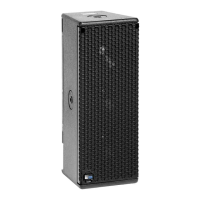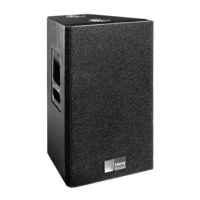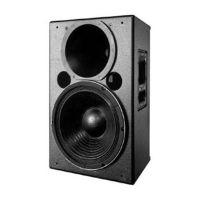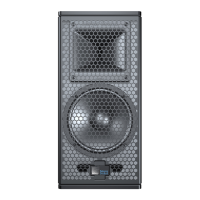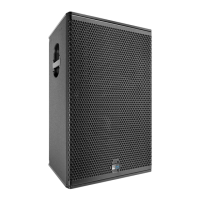16
CHAPTER 4
Engaging the Lo-Cut Filter
Using the LD-1A, LD-2 or LD-3 Lo-Cut filter (160 Hz
position on the LD-3) with a system comprising UPM-1P or
UPM-2P loudspeakers and subwoofers in close proximity
and co-planar will produce a very flat frequency response
with a minimal area of overlap. The UPM-1P or UPM-2P
loudspeakers in the system receive their signal following
a high-pass filter, while the subwoofers apply their normal
internal crossover frequencies to a full range signal. To
achieve this flat response, the subwoofers need to have
their polarity reversed.
TIP: The flatness of the response is
dependent on proximity to boundary
surfaces.
While the change of polarity with respect to a daisy-chained
configuration is needed due to the phase shift caused by
the high-pass filter at overlapping frequencies, placing
subwoofers more than 4 feet apart from UPM-1P or UPM-
2P loudspeakers may require reversing the polarities once
again to compensate for the delay propagation.
NOTE: When driving UPM-1P or UPM-2P
loudspeakers from the Mid-Hi output of the
LD-1A, LD-2 or LD-3 line driver — with the Lo-Cut
filter engaged (160 Hz position), and USW-1P or
UMS-1P subwoofers in their full-range configuration
— their polarities should be reversed if they are
co-planar or near each other. The simplest way to
achieve this is by engaging the “reverse polarity”
switch on the sub output of the line driver.
If your UPM-1P or UPM-2P loudspeakers and UMS-1P/
USW-1P subwoofers are separated by a greater distance
— or delay must be used between them — a measurement
system such as the SIM audio analyzer should be used to
determine the correct delay and polarity.
DIGITAL SIGNAL PROCESSORS
Full-range signals may be applied to Meyer Sound’s
self-powered loudspeakers because they have built-in
active crossover circuits; external crossovers and digital
signal processors (DSP) are optional and should be used
very carefully as phase shifts can cause destructive
cancellations.
If a DSP is used, the UPM-1P or UPM-2P loudspeakers
and subwoofers should be fed from the DSP in order to
keep their delay time the same and avoid any phase shift
differences between the UPM-1P or UPM-2P loudspeakers
and the subwoofers. In addition, it is good practice to verify
that the delay time between channels is correct: Some
DSPs may develop channel-to-channel delay errors when
the DSP is near maximum throughput.
In no case should a filter higher than 2nd order be used.
The additional phase shift introduced deteriorates the
impulse response and higher roll-off does not improve
crossover interaction. In fact, it is highly recommended that
the crossover/filter is set to emulate the low-cut LD-1A, LD-
2 and LD-3 (160 Hz position) characteristics themselves, as
shown in Table 4.1.
Table 4.1: LD-1/LD-2/LD-3 Lo-Cut Filter Parameters
Type Order Pole Frequency Q
High Pass 2
nd
(-12dB/oct) 162 Hz 0.82*
*If the DSP does not have variable Q for high-pass filters, the filter should be
set to “Butterworth” (Q ≈ .7).
If the loudspeakers are going to be driven directly from
DSP, verify that the outputs of the processor have the
driving capabilities to drive the total load presented by the
loudspeakers connected to it.
NOTE: When precise system design,
subwoofer integration, DSP and delay
systems, and compensation for acoustical
conditions all come into play, measurement and
correction tools are a must. Meyer Sound’s SIM
audio analyzer; LD-1A, LD-2 and LD-3 line drivers;
and the CP-10 parametric equalizer are highly
recommended.

